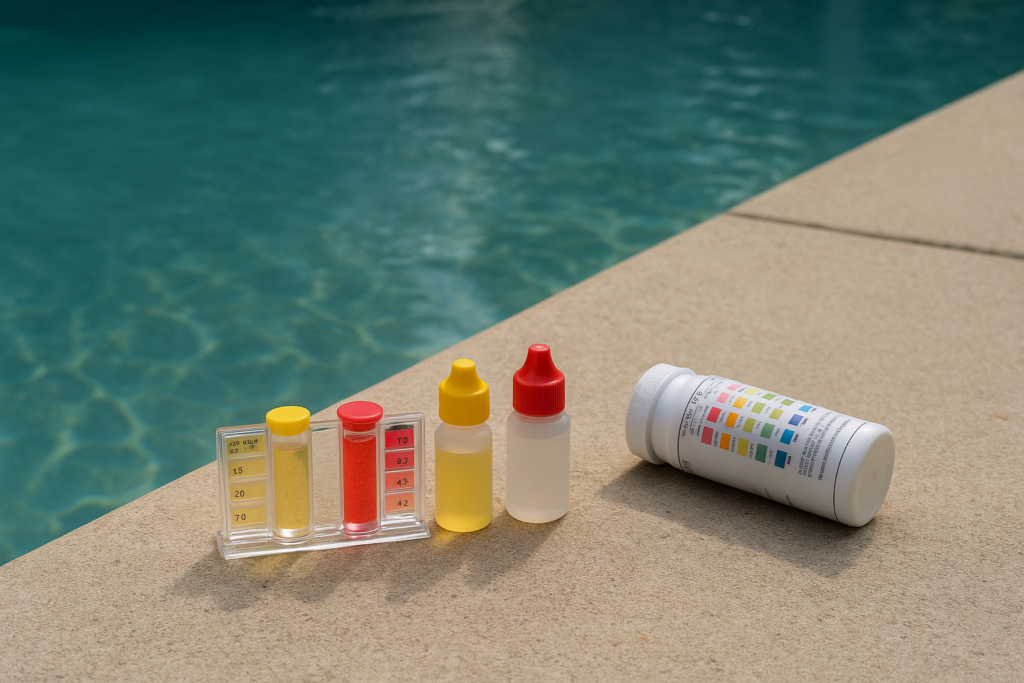How to Test Your Pool Water Like a Pro

Clear water doesn’t always mean clean water. Just because your pool looks beautiful doesn’t mean the chemistry is balanced, and when it’s not, it can lead to algae blooms, skin irritation, damaged equipment, and even long-term surface problems. The good news? Testing your pool water doesn’t have to be complicated. With a few tools and the right know-how, you can check your levels just like the pros.
Why Water Testing Matters
Balanced water protects:
– Swimmers: Prevents red eyes, dry skin, or rashes
– Surfaces: Avoids etching, scaling, and staining
– Equipment: Keeps pumps, filters, and heaters running efficiently
– Sanitizers: Helps chlorine and other treatments work properly
Ideally, test your water once a week during pool season, more often after heavy rain, a pool party, or algae treatment.
What You’ll Need
Option 1: Test Strips (Beginner Friendly)
– Quick and easy
– Color-coded results
– Measures basic levels: chlorine, pH, alkalinity, etc.
Option 2: Liquid Test Kit (More Accurate)
– Uses reagents and color comparison
– More reliable than strips
– Often tests for a broader range of chemicals
Option 3: Digital Testers or Apps (Advanced)
– Instant readings
– Some integrate with phone apps
– Great for data tracking, but more expensive
The 6 Key Levels to Test
Free Chlorine: 1.0 – 3.0 ppm
– What it affects: Kills bacteria and algae
pH: 7.2 – 7.6
– What it affects: Swimmer comfort and equipment longevity
Total Alkalinity: 80 – 120 ppm
– What it affects: Helps stabilize pH
Calcium Hardness: 200 – 400 ppm
– What it affects: Prevents plaster damage and scaling
Cyanuric Acid: 30 – 50 ppm (outdoor pools)
– What it affects: Protects chlorine from sun exposure
Phosphates: As low as possible
– What it affects: Can fuel algae growth
How to Test (Step-by-Step)
Using Test Strips:
1. Dip a strip 6 inches into the pool, away from returns.
2. Hold underwater for 2–3 seconds, then remove.
3. Wait 15–30 seconds.
4. Compare to the chart on the bottle and write it down!
Using a Liquid Test Kit:
1. Collect water from elbow-depth (away from jets).
2. Fill test vials to the marked line.
3. Add the correct number of drops for each reagent.
4. Cap and mix gently.
5. Match color results to the guide provided.
Pro Tip: Always test at the same time of day and from the same spot to maintain consistency.
When to Adjust
Low chlorine? Add shock or liquid chlorine.
High pH? Use muriatic acid or pH decreaser.
Low alkalinity? Add sodium bicarbonate (baking soda).
Low hardness? Add calcium chloride.
High cyanuric acid? Dilute by partially draining/refilling the pool.
Bonus Tips
Store test kits in a cool, dry place, reagents expire!
Don’t test after a rainstorm, wait at least 12 hours for accurate results.
Record your results weekly to track trends or issues.
Need help balancing your water?
Call us at (843) 708-9414 or schedule a service visit online. Let the experts at Maritime Pools keep your water safe, clean, and crystal clear all season long.